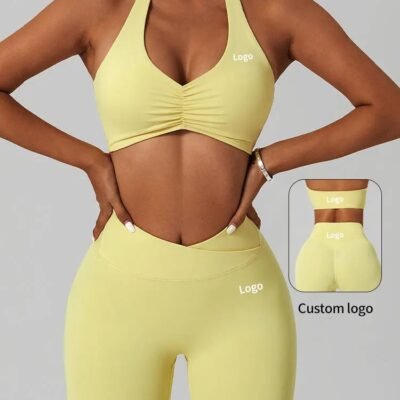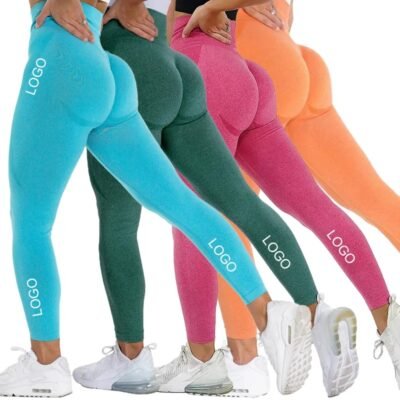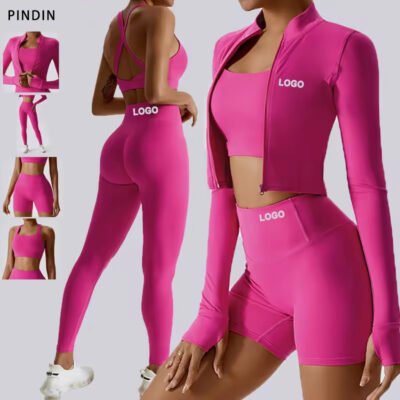Choosing the right fabric for yoga pants is essential to ensure comfort, flexibility, and durability during practice. The right material can make a significant difference in your yoga experience, providing the support and breathability needed to perform poses with ease. This article will guide you through the key factors to consider when selecting the fabric for yoga pants.
1. Key Qualities to Look for in Yoga Pants Fabric
- Stretchability: Yoga requires a full range of motion, so the fabric needs to stretch with your body without losing shape. Look for materials with a good amount of spandex or elastane, which offer excellent stretch and recovery.
- Breathability: Yoga can be physically demanding, and a breathable fabric is crucial to keep you cool and comfortable. Fabrics that allow air circulation help prevent overheating and manage sweat effectively.
- Moisture-Wicking: Fabrics that wick moisture away from the skin are essential, especially for intense or hot yoga practices. Moisture-wicking materials keep you dry and prevent chafing or irritation.
- Durability: The fabric should withstand regular stretching, washing, and wear without pilling, tearing, or losing its elasticity. Durability is important for ensuring that your yoga pants last through many sessions.
- Comfort: Softness and comfort are key. The fabric should feel good against the skin, without causing irritation or discomfort during movement.
2. Common Fabrics Used in Yoga Pants
- Cotton
- Pros: Cotton is soft, breathable, and comfortable. It’s a natural fiber, making it a great choice for those with sensitive skin. Cotton is also easy to care for and can be blended with other fibers for added stretch.
- Cons: While comfortable, cotton alone lacks the stretch and recovery needed for yoga pants. It also absorbs moisture rather than wicking it away, which can make it feel heavy and damp during sweaty sessions. Cotton-blend fabrics are a better option.
- Polyester
- Pros: Polyester is a synthetic fiber known for its durability, moisture-wicking properties, and resistance to shrinkage and wrinkles. It’s often blended with spandex to create a fabric that is both stretchy and resilient.
- Cons: Polyester can sometimes trap odors and may not be as breathable as natural fibers. However, high-quality polyester blends are designed to improve ventilation and comfort.
- Nylon
- Pros: Nylon is another popular synthetic fiber for yoga pants. It’s strong, lightweight, and has excellent moisture-wicking properties. Nylon is also resistant to abrasions and pilling, making it durable for frequent use.
- Cons: Like polyester, nylon can trap odors and might not be as soft as other fabrics. However, modern nylon blends often address these issues by incorporating other fibers for added comfort.
- Spandex/Elastane/Lycra
- Pros: Spandex is known for its exceptional stretch and recovery, making it a key component in yoga pants fabrics. It allows for unrestricted movement and helps the pants maintain their shape after repeated use.
- Cons: Spandex is usually blended with other fibers, as it is not typically used on its own due to its tendency to degrade with high heat or prolonged exposure to chlorine.
- Rayon/Viscose
- Pros: Rayon is a semi-synthetic fiber made from natural sources like wood pulp. It’s soft, breathable, and can mimic the feel of silk or cotton. Rayon is often blended with spandex for stretch.
- Cons: While comfortable, rayon isn’t as durable as synthetic fibers like polyester or nylon. It can also lose strength when wet and may shrink if not properly cared for.
- Bamboo
- Pros: Bamboo fabric is a sustainable and eco-friendly option. It’s naturally antibacterial, moisture-wicking, and soft, making it comfortable for yoga wear. Bamboo is also breathable and has a natural sheen.
- Cons: Bamboo fabric can be more expensive and may not offer the same level of stretch as synthetic blends unless it’s combined with spandex or elastane.
3. Fabric Blends for Yoga Pants
Blended fabrics are often the best choice for yoga pants because they combine the strengths of different fibers. Some popular blends include:
- Cotton-Spandex Blend: This blend offers the comfort and breathability of cotton with the stretch and recovery of spandex. It’s a good choice for low-impact yoga practices or casual wear.
- Polyester-Spandex Blend: This blend is durable, moisture-wicking, and offers excellent stretch, making it ideal for high-intensity or hot yoga sessions.
- Nylon-Spandex Blend: Known for its smooth finish and durability, this blend is perfect for activewear. It’s moisture-wicking, quick-drying, and offers a snug, supportive fit.
- Bamboo-Spandex Blend: For those seeking a sustainable option, this blend combines the eco-friendly properties of bamboo with the flexibility of spandex, resulting in a soft, breathable, and stretchable fabric.
4. Choosing the Right Fabric Based on Your Yoga Practice
- Hot Yoga: For hot yoga, moisture-wicking and breathable fabrics are crucial. Look for a polyester-spandex or nylon-spandex blend that dries quickly and allows for maximum airflow.
- Vinyasa/Power Yoga: These dynamic practices require yoga pants that can move with you. A nylon-spandex blend offers the durability and stretch needed for high-energy flows.
- Restorative Yoga: In gentler practices, comfort is key. A cotton-spandex or bamboo-spandex blend provides the softness and ease needed for long holds and relaxation.
- Everyday Wear: If you plan to wear your yoga pants beyond the studio, consider a midweight cotton-spandex blend. It offers comfort and versatility for casual wear.
5. Personal Preferences and Fit
- Texture: Some prefer the smooth, sleek feel of synthetic blends, while others may favor the soft, natural feel of cotton or bamboo.
- Thickness: Depending on your comfort level, you may choose a thicker fabric for more coverage or a lighter, thinner material for breathability.
- Compression: Fabrics with a higher percentage of spandex offer more compression, providing support and a snug fit. Consider your preference for compression when selecting fabric.
6. Care and Maintenance
Different fabrics have varying care requirements:
- Synthetic Blends: Typically machine-washable, but it’s best to wash them in cold water and avoid fabric softeners, which can break down the fibers.
- Natural Fibers: Cotton and bamboo blends may require gentler care, such as air drying or washing on a delicate cycle to prevent shrinking or wear.
Conclusion
Choosing the right fabric for yoga pants is essential for comfort, performance, and durability. By understanding the characteristics of different fabrics and considering factors like your yoga practice, personal preferences, and care requirements, you can select yoga pants that meet your needs and enhance your overall experience. Whether you opt for the moisture-wicking properties of synthetic blends or the softness of natural fibers, the right fabric can make a significant difference in your yoga practice.









